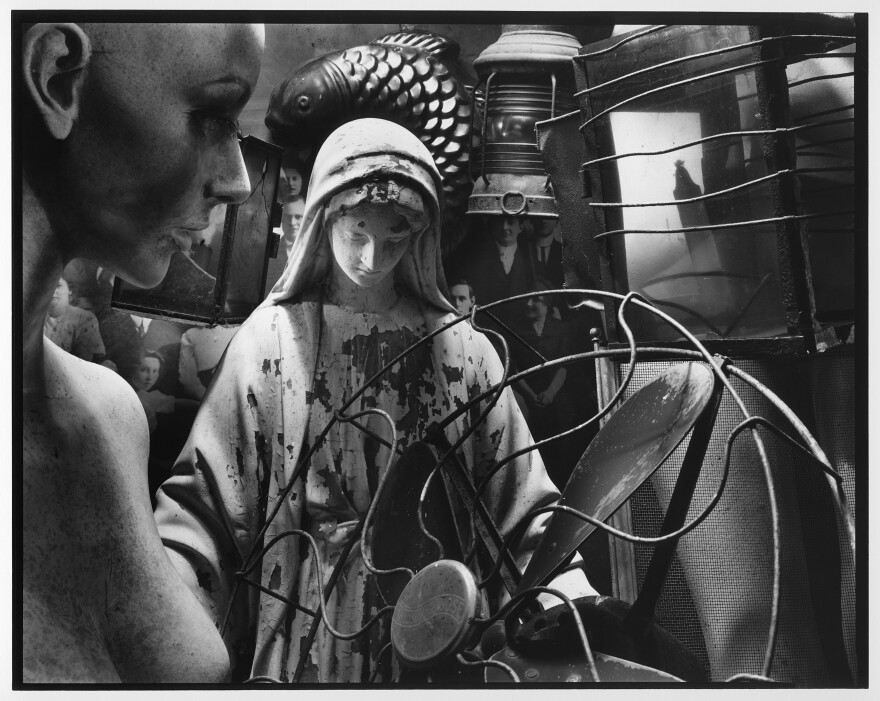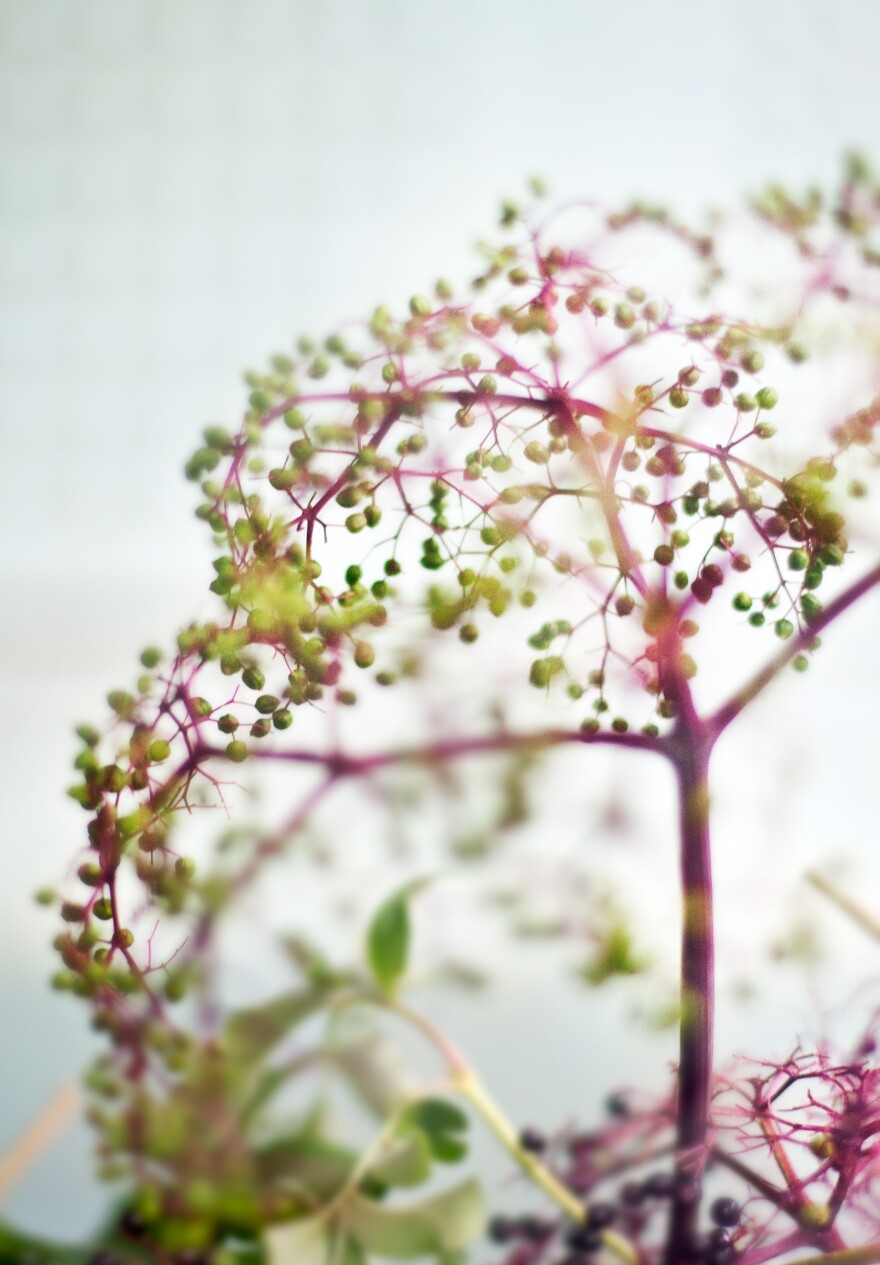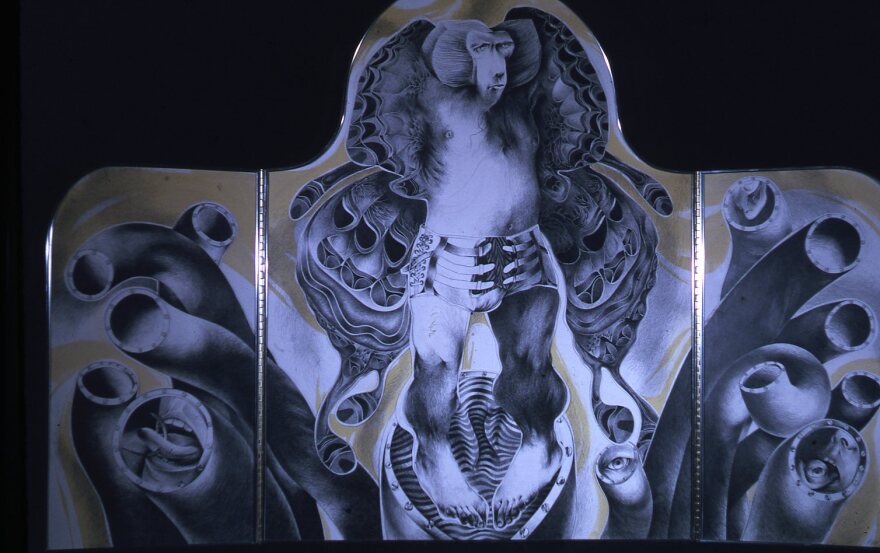Davin Watne and Barry Anderson were feeling some pressure.
“It’s been a while since you’ve had a faculty show,” people kept reminding Watne, the curator and director of the UMKC Gallery of Art.
“Or an alumni show,” Anderson, the chair of the studio art department, kept hearing.
In response, they tripled down. Arterial Echoes: Three Generations of Creative Mentoring puts the work of current professors up next to the work of their professors and their students, so visitors can see the fertile progression of trends, techniques and ideas.
Or, as Watne puts it, "the generational pass-down, the mutations and transferences."
That's obvious in the trio of paintings from Watne, his mentor, and his student.
At first glance, the big painting on the left, by Watne's mentor Timothy App, has little in common with the tiny painting in the middle, by Watne's student Andrew McIlvaine; neither seems similar to Watne's own big painting on the right. But knowing their relationships makes certain elements clearer: All three painters work with a square canvas, all three paintings use similar color palettes and rectangular motifs, and all three painters, in one way or another, comment on the ambiguities of modern existence.

"Timothy was working in straight-up late-'60s modernism," Watne explains, "so he was following all those conventions and strict rules: everything had five-to-seven shapes, all rectangles, all black and white and three primary colors."
McIlvaine, meanwhile, is interested in "surreal landscapes and subtle references to conflict between man and nature," Watne says.
For his own part, Watne says, he likes to "play with inverting things." So in his depiction of mounted police, he inverts the colors and flips images upside down, he says, "to complicate the quick-read messages we get from our leaders and the media, to show they're not as simple as what we get with our daily news consumption."
In that way, Watne's tableau is as surrealistic as McIlvaine's, and App's stark landscape may be the most surrealistic of all.
Watne doesn't know what App thinks of McIlvaine's work, because he hasn't figured out a way to get all of the show's mentors and mentees together for such a conversation — but he wants to, and hopes that will be possible before the show closes at the end of October.
In other cases the artists are well aware of what their mentors and mentees think, Anderson says, noting that faculty member Kati Toivanen already owned the piece by her mentor, Stephen DiRado, and her mentee,Sarah Kraly.
"She owns them for a reason," Anderson says.

Paul Tosh, meanwhile, collaborated with student Danny Staton to create a piece specifically for the show: a standing sculpture called "Urban Cube." On two sides are Tosh's comic-bookish social commentaries, and on the opposite sides are Staton's graphic-designed representations of a world in chaos. On the wall behind them is the piece by Tosh's mentor, Ollie Fancher: Emerging from industrial intestinal tubes, a meticulously drawn, black and white, wise butterfly-monkey observes.

Watne says he didn't have to exert much curatorial effort. "It came together serendipitously and organically," he says.
Faculty members decided which pieces of their own to contribute, and coordinated with their own mentors and students to obtain work for the show.
"It shows the spidery network of how this all works," Anderson says.
As it turned out, his mentor, Lawrence McFarland, was an MFA student at the University of Nebraska in Lincoln back in the 1970s, when his colleague Hye Young Shin's mentor, Adele Henderson, was a BFA student at Nebraska.
"It's a dialog going back forty or fifty years," Anderson says of the show.
McFarland's piece is a black-and-white photograph of a van parked at a lonely crossroads in the bleak Mojave Desert. Next to it, bluish lights wash across a dark screen in an HD video animation by Anderson's student, Stanila Syarova. Her high-tech medium makes McFarland's silver gelatin print look almost antique — but the digital lights in her piece could also be the stars above McFarland's desert sky (or the night lights of Las Vegas, an hour and a half away from the Mojave).
With these two contrasting pieces from his mentor and his mentee, Anderson at first didn't know what he should contribute.

"Should I make something new to try to make a transition, build a bridge between those two pieces? Or should I do something completely different?" he wondered, noting that lately he's been making sculptures, which is "a whole different approach."
He decided on "Fragments of Space." Requiring its own black-curtained room, the piece is a wall-sized projection in which dark pinkish paths of concrete walkways and railings are constantly shifting and bobbing in a floor of water. Occasionally the green head of a Wall Street bull appears just above the water's surface.
"It's a digitally fabricated labyrinth, from a new series I'm doing on psychological landscapes," Anderson explains.

Like his mentee Syarova's piece, it's an HD video animation; his mentee's photographed desert is a psychological landscape as well as a literal one.
"For a curator," Watne says, "it’s fun to let this open up and literally see it in front of you."


And to ensure the show opens up entirely for gallery visitors as well, Watne involved a fourth layer — or generation — of UMKC art education: Each essay in the catalog was written by an alum from the art history program.
In the final essay, recent alum Caleb Stockham is writing about Hye Young Shin, Adele Henderson and Andrew Julo, but his last line applies to the whole show: "One can note visual and thematic resonances among these works that highlight universal concerns."
Arterial Echoes: Three Generations of Creative Mentoring, through October 28 at the UMKC Gallery of Art, Fine Arts Building, 5015 Holmes St., Kansas City, Missouri, 64110, 816-235-1501.
C.J. Janovy is an arts reporter for KCUR 89.3. You can find her on Twitter, @cjjanovy.




